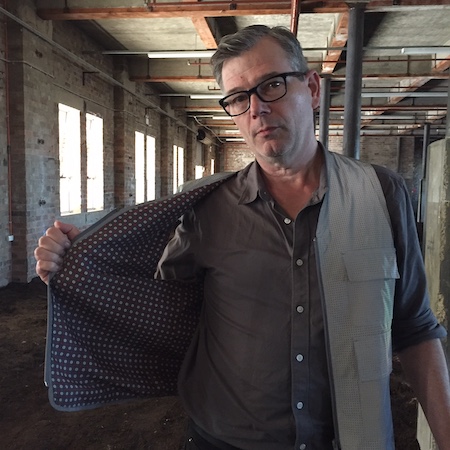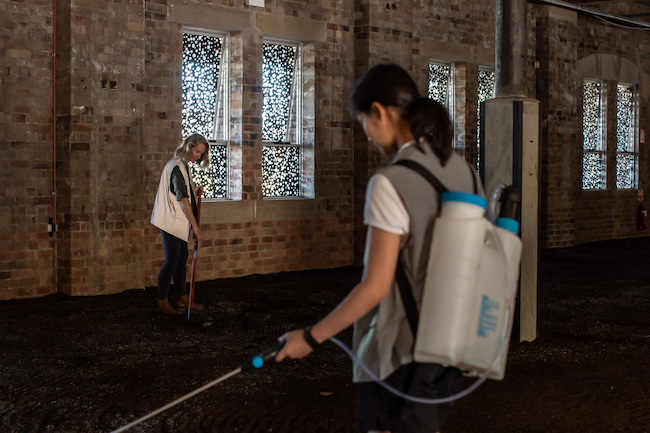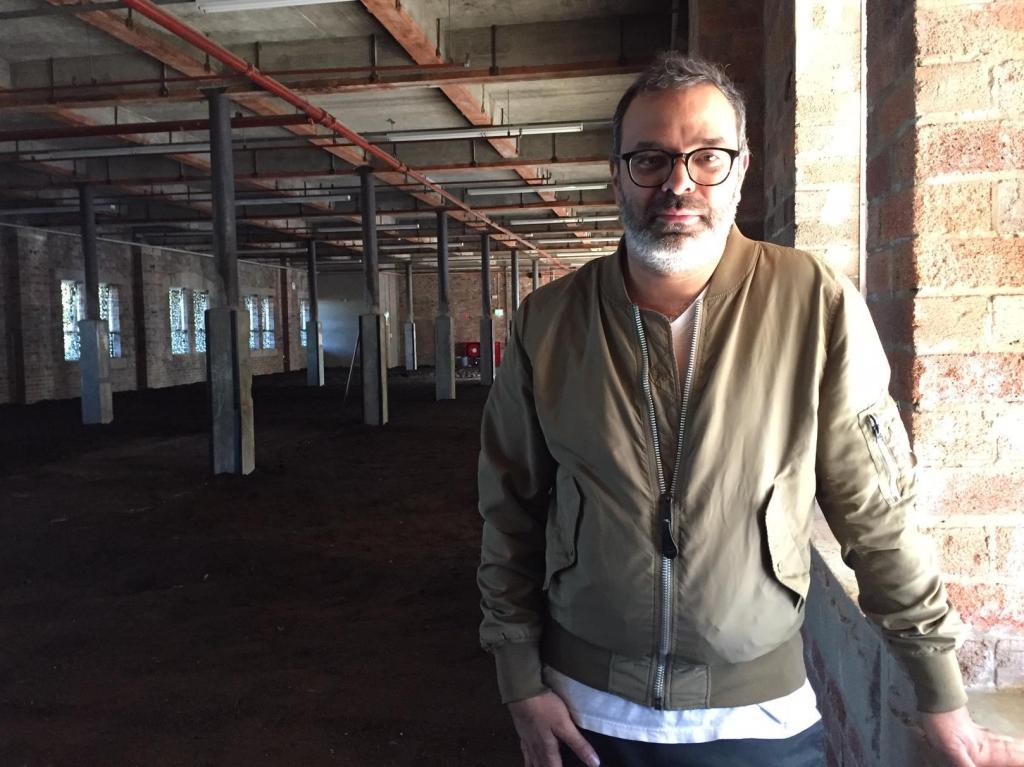Artist Asad Raza at The Clothing Store. Image: ArtsHub.
Artist Asad Raza (New York/Berlin) has garnered a reputation globally for interactive, unconventional projects that are very site-specific. For example, for the celebrated Whitney Biennial in 2017, he embedded a field of trees inside the gallery, each attended by a ‘carer’, and on another occasion invited artists and friends to curate the object placement in his apartment.
Raza was invited by art patron John Kaldor to create Project 34 for the Kaldor Public Art Project (KPAP) – the result is Absorption, 300 tonnes of soil that fills The Clothing Store at Carriageworks.
They are not the sort of projects that your average punter would immediately call ‘art’. As the room brochure promotes, Raza ‘creates artworks as “zones of activity”’.
Kaldor has always provoked audiences’ understandings of the parameters of contemporary art. We can track that legacy back to the foundations of KPAP when the artists Christo and Jean-Claude wrapped Little Bay, Sydney. My guess is that in 1969, people would have equally asked the question, ‘Is this art?’
Around the same time in Germany, it was the Land Artist Walter De Maria who first filled a room with soil.
He created his Earth Room in 1968 in Munich, then recreated it at the Hessisches Landesmuseum in Darmstadt, Germany in 1974, and again in 1977 in Soho, New York – the only surviving example, which is managed by the Dia Art Foundation.
I suppose we can’t entirely consider Raza’s project without a nod to Walter De Maria, however their motivations were very different.
KPAP Director John Kaldor said Raza’s work ‘very much reflects the spirit of our time’.
This work of Raza’s sits comfortably within a global zeitgeist of artists who embrace the intersection of art and science as a means to draw attention to the urgency of environmental concerns. It also taps into another art world zeitgeist: one that blurs the boundaries of performance, installation, research, authorship, and dwells less on hierarchy and rather on the wellness of making.
Key to this Kaldor project is the way that Raza has brought in other artists.
Aboriginal artist Daniel Boyd has contributed perforated window screens that create a dappled light within the Clothing Store; Agatha Gothe-Snape has contributed vests worn by the cultivators from vintage Kaldor fabrics; Khaled Sabsabi has buried a grid of turf underneath the soil; Jana Hawkins-Andersen’s clay works are broken up to enrich the soil; Megan Alice Clune’s sound piece reacts to the soil changing state and pH levels when attended with a probe, while Dean Cross’s introduced a kilogram of earth from 1000km away.
They are very subtle, or largely unseen interventions – that for Raza complete the work.

Cultivator wearing Agatha Gothe-Snape, Discrete Relations/Discreet Relations, John Kaldor Fabricmaker remnants (various materials), silver thread, light reflective perforated polyester. Kaldor Public Art Project 34: Asad Raza, Absorption, 2019. The Clothing Store, Carriageworks. Image: ArtsHub.
He said: ‘I work with whoever seems appropriate to the project at hand …. it’s more psychologically motivating to be part of a team, and more fun not to able to fully control what’s happening,’ adding that for him exhibition making was ‘another way to cook experiences.’
Just like The Earth Room, the most immediate impact entering Raza’s project is the pungent smell of the soil itself. But we are slowly encouraged to enter deeper into this world that Raza and his cultivators have created, and find ourselves searching for something to grab onto in the space. It feels illusive; unfamiliar.
‘I use groups of people as a force of connection between the various elements, a mechanism of exchange,’ Raza explained.
Clearly we are willing as viewers, having been drawn to the space knowingly that it was 300-tonnes of soil. What then is the curiosity, the connection, and do we feel satisfied by the experience?
My guess is, that measure has more to do with our societal longing for wellness than for good contemporary art – that is, the search for more empathy and better connection with our environment. There is also that STEM // STEAM conversation that we hope to see better embedded in how a next generation approaches the world.
Absorption then is a stellar case study.
Raza has additionally collaborated with biologists, environmental scientists, gardeners and architects to realise Absorption, and with a team of six volunteers in the space each day tending the soil – turning it over, watering it – these worlds come very close. It feels like a natural fit.
This is the real success of Raza’s project, more than its physical experience.

Kaldor Public Art Project 34: Asad Raza, Absorption, 2019. The Clothing Store, Carriageworks. Image: Pedro Greig.
Absorption nurtures not only the health of the soil – and ideally our own take-away message for greater environmental care – but also nurtures a really collegiate hub for creatives and thinkers.
Over the 16 days Raza uses the space – the exhibition – as the site for a pop concert by Chun Yin Rainbow Chan; to present a new choreographic piece by Ivey Wawn in collaboration with Ivan Cheng, Daniel Jenatsch, Eugene Choi, and Taree Sansbury; as the location for an event hosted by Kandos School of Cultural Adaptation; dinners; panel discussions; a performance by Brian Fuata; and a reading hosted by feminist reading group Composting.
Raza concluded: ‘I’ve been trying to make holistic experiences that go beyond the purely visual sense, and beyond perception, into proprioception, the feeling of your body as you move in the world.’
In our world of art making where we are encouraged to be innovative, to reach outside our silos and to engage others – the language of support mechanisms – I can’t help but find this project to be a fascinating case study.
3 stars ★★★
Asad Raza: Absorption
3-19 May 2019
Kaldor Public Art Project 34
The Clothing Store, Carriageworks, NSW
Collaborators include Daniel Boyd, Stephen Cattle, Chun Yin Rainbow Chan, Megan Alice Clune, Dean Cross, Brian Fuata, Agatha Gothe-Snape, Jana Hawkins-Andersen, Alex McBratney, Khaled Sabsabi, and Ivey Wawn.





